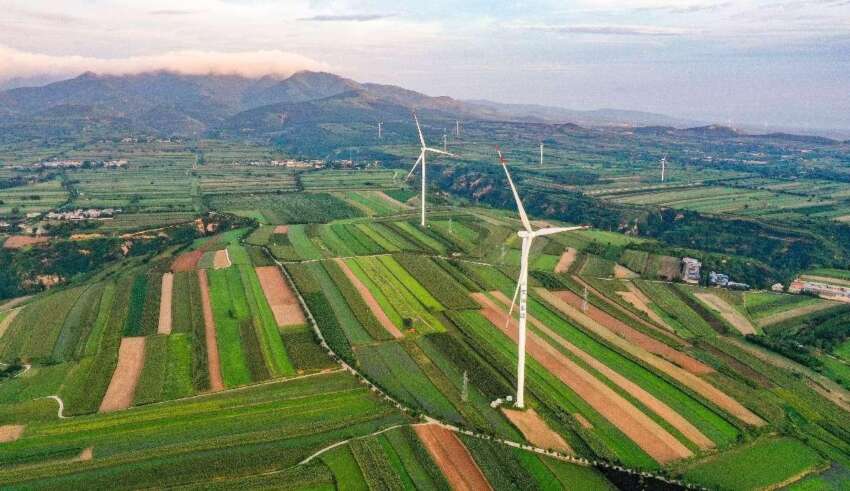
At 12:28 p.m., Aug. 27, solar power generation in the power grid of north China’s Shanxi province surpassed 20 million kilowatts for the first time, setting a new record and accounting for 63.9 percent of the province’s electricity load.
In response, coal-fired power plants proactively reduced their output to make room for renewable energy, ensuring safe and stable operation of the power grid throughout the day.
Shanxi, a major coal-producing province in China, has over 48.3 billion tons of proven coal reserves, accounting for 23.3 percent of the national total.
The province has reaped some early fruits in recent years in the pilot programs of comprehensive energy reform. Advanced capacity of coal production now makes up 82 percent of the total, and the province accounts for 43 percent of all in-service intelligent mining faces in China. From 2021 to 2023, the province achieved a 10.9 percent reduction in energy consumption intensity, among the highest in China.
In its push to advance the energy revolution, Shanxi is driving its traditional coal industry toward higher-end, higher-quality, and more efficient operations.
At the No.2 coal mine of Shanxi Huayang Group New Energy Co., Ltd., coal shearers 300 meters underground started working after a staff member had a few clicks on a mouse in a dispatch and command center. Real-time footage of mining, tunneling and coal transportation was shown on a high-definition screen.
A miner with 28 years of mining experience told People’s Daily that mining relied heavily on manual labor in the past, and a single mining team could only extract 50,000 tons of coal per month.
“Now, the entire process is mechanized, with robots performing inspections. It saves manpower, allowing a team to mine 300,000 tons a month,” said the miner, Xue Biao, head of the mining team one of the No.2 coal mine.
Shanxi is also promoting safer production in coal mining enterprises, with a total of 133 intelligent coal mines now in operation. There are 756 operational intelligent mining faces across the province, and the share of advanced coal production capacity in the province has risen from 68 percent in 2019 to 82 percent this year.
To address the environmental challenges posed by coal mining, Shanxi is employing green mining technologies such as backfill mining, water-conserving extraction, and co-mining of coal and gas. The province has established 30 pilot demonstration green mines, which have effectively reduced waste rock emissions, surface subsidence, and water damage, helping improve the ecological environment of mining areas.
Accelerating technological upgrades and promoting the clean utilization of coal are also key components of Shanxi’s energy revolution.
At Shanxi Ruiguang Power Co., Ltd., coal must undergo a comprehensive “health check” upon entering its factory.
Coal samples are automatically sent through pipelines into a robotic intelligent testing system, where it takes eight hours to analyze 30 parallel samples. The system tests for parameters such as calorific value and chemical composition, with the results automatically recorded and uploaded, providing science-based data for power generation.
According to reports, the company officially launched an intelligent combustion optimization system at the end of October last year. This system utilizes advanced monitoring and intelligent control technologies to dynamically adjust key data like boiler temperature and air distribution, optimizing coal combustion for maximum efficiency.
The launching of the system could save approximately 3,000 tons of standard coal and reduce carbon dioxide emissions by 7,920 tons per year.
In addition, Shanxi is speeding up energy-saving and efficiency-improving upgrades for coal-fired power units, as well as modifications for heating and operational flexibility. The province’s coal power structure is continuously optimized and upgraded. Between 2021 and 2023, Shanxi eliminated 2.45 million kilowatts of outdated capacity of coal-fired power units and completed upgrades on over 65 million kilowatts of existing units, resulting in a reduction of 12 grams of coal consumption per kilowatt-hour compared to 2020.
In addition, Shanxi is rapidly advancing the development of renewable and clean energy sources, including solar, wind, hydrogen, and geothermal energy. As a result, the province’s energy supply is transitioning from relying solely on coal to a more diverse and environmentally friendly mix of sources.
Building on its coal resources, Shanxi has reached a new level in the large-scale development of coalbed methane, with annual production exceeding 10 billion cubic meters, accounting for around 80 percent of the national output.
In 2023, the hydrogen energy industry in Shanxi reported a revenue of over 50 billion yuan ($7.04 billion), and the methanol automobile industry continued to grow, with the province accelerating the building of a one-hundred-billion-yuan methanol economy.
As of the end of July this year, Shanxi’s installed capacity of new and clean energy exceeded 65 million kilowatts, representing 47.8 percent of the province’s total installed capacity. The utilization rate of new energy has remained above 97 percent.
Shanxi is also enhancing the regulation capabilities of its energy storage stations. After receiving an information about a surplus of wind and solar power, the Wangning power storage station started charging at 12:45 p.m. It stored 280,000 kilowatt-hours of electricity in less than two hours. After 8:00 p.m., as wind and solar output declined, the station began releasing power back to the grid.
“Energy storage stations are like large ‘power banks’ for the grid. They can quickly balance the fluctuations caused by new energy with millisecond-level response time,” said Chang Xiao, director of the grid technology center at the electric power research institute under State Grid Shanxi Electric Power Company.
As of July this year, Shanxi had put 16 energy storage stations into operation, with a total regulation capacity exceeding 1.27 million kilowatts, making the province’s power supply more stable and reliable.
In Shanxi, the concept of energy conservation and emission reduction has been widely embraced by the people. Currently, over 90 percent of new buildings in the province are classified as green buildings, and more than 90 percent of urban and rural areas have adopted clean heating systems. Additionally, in all 11 cities divided into districts, the entire fleet of buses and taxis has been replaced with new energy vehicles.








